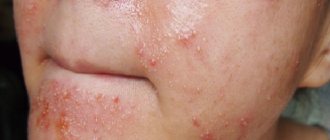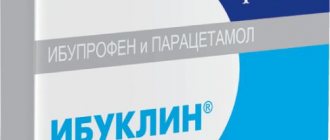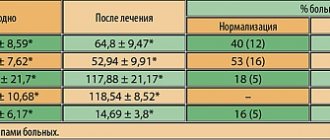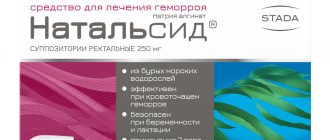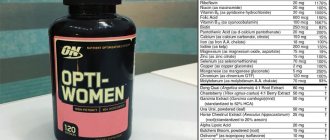Composition and dosage form
Ascorutin contains 2 active components:
- rutoside (rutin, vitamin P): necessary for normal microcirculation of substances in cells, fluid outflow, strengthening and maintaining the elasticity of vascular walls;
- ascorbic acid (vitamin C): important for general metabolism, absorption and conversion of nutrients into energy, tissue trophism, maintaining immunity, synthesis of collagen and muscle fibers.
Ascorutin is produced in the form of tablets containing 50 mg. ascorbic acid and rutoside of natural origin. An extract from black currant berries is often used as a starting material, so the taste of the pills is pronounced, sweet and sour. Uncoated pills have a yellowish or light green color with small inclusions. Among the formative and additional components of the drug: sugar, starch, magnesium stearate, MCC and other compounds.
The drug Ascorutin D of a similar composition and form contains sorbitol instead of sugar and is safe for patients with diabetes.
How does Ascorutin work?
The vitamins contained in the drug quickly dissolve in the stomach and are absorbed through the mucous membrane into the blood. In the complex, ascorbic acid and rutoside complement and enhance each other’s effectiveness. Both compounds are active antioxidants. They help reduce intoxication of the body during inflammatory and infectious processes, increase resistance, regulate blood clotting and fluidity, preventing red blood cells from sticking together.
In the complex therapy of vascular diseases, Ascorutin helps restore peripheral blood supply, restore the integrity of capillaries, prevent and eliminate edema, trophic ulcers, improve the supply of nutrients to tissues and the removal of toxins.
Main indications for taking Ascorutin
The drug is prescribed to prevent the development and treatment of pathologies accompanied by insufficient blood circulation, blood disorders or vitamin deficiency. Among them:
- tendency to increased platelet formation;
- vascular damage by salicylates;
- hemorrhagic diathesis;
- hemorrhage in the retina;
- violation of intraocular pressure;
- atherosclerotic changes;
- rheumatism;
- Iron-deficiency anemia;
- some forms of hypertension;
- venous insufficiency;
- varicose veins: lower extremities, rectum;
- trophic ulcerative lesions;
- thrombophlebitis;
- consequences of severe scarlet fever, measles;
- frequent nosebleeds;
- changes in blood composition as a result of radiation exposure.
In most cases, Ascorutin is indicated in combination with other medications or vitamin-mineral medications.
As an adjuvant, Ascorutin is used in vitamin therapy for menstrual disorders: for heavy or irregular discharge. Its regular use helps to normalize pancreatic function and the absorption of glucose by cells. This helps stabilize the condition of diabetic patients at an early stage.
For diseases of the joints and spine, the product improves metabolic processes in the tissues of cartilage and skeleton, prevents the leaching of calcium, supports the formation of intra-articular lubrication, and slows down inflammatory reactions.
Ascorutin tablets - reviews
elivanch
https://citykey.net/review/chemu-byit-togo-ne-minovat-ili-pochemu-askorutin-mne-ne-pomog
I had to deal with ascorutin several times in my life. The first time was in elementary school, when my vision began to deteriorate. After a visit to the ophthalmologist and all examinations, ascorutin, eye exercises and regular physiotherapeutic procedures were prescribed. I really liked the taste of these vitamins; taking them was a pleasure. As I understand it, ascorutin was prescribed to strengthen the eye vessels.
What can we say about efficiency? My vision still deteriorated and I had to wear glasses. But is ascorutin to blame for this? Of course not! Myopia is hereditary in our family, although it only started for me after the first grade. It’s called what happens, cannot be avoided.
Several years ago, spider veins began to appear on one leg. And I have already prescribed Ascorutin to myself. The condition of the leg was not getting better, but not worse. And then pregnancy and that’s it, varicose veins began. Does this mean that ascorutin is not effective? No! History repeats itself: and if I got myopia from my mother, then varicose veins - from my dad.
In my case, these vitamins did not help, but this is due to a genetic predisposition to both myopia and varicose veins. No remedy will help here.
1S.
https://flap.rf/Medicine/Ascorutin/Reviews/6686402
I first learned about Ascorutin when I went to the doctor for help because of a sharp pain in my leg and a huge bruise appeared. This scared me very much, so I told the doctor about it as soon as possible in order to prevent the danger and take care of my health in advance. The doctor said that it was a burst vessel, since blood vessels tend to lose elasticity, the walls of the vessel become fragile, and an unpleasant story like mine happens.
She prescribed me Ascorutin in combination with venosmin, which give excellent results. I took it after meals, since it should not be taken on an empty stomach; after all, ascorutin contains acid, it irritates the gastric mucosa. You should not chew it, otherwise your teeth can be damaged, and you should swallow it whole. The price for this drug is affordable, it cost about 25 rubles, so for vascular diseases you can buy and undergo a course of treatment, but only in combination, otherwise there will be no result. At least that's what the doctor told me.
I recommend taking Ascorutin as a course for those who suffer from weak blood vessels and are afraid of it. I actually had fear when I saw a burst blood vessel, or rather a huge bruise suddenly appeared. The advantage of Ascorutin is that it contains ascorbic acid, which is a vitamin for the body.
Oksana Sakharova
https://flap.rf/Medicine/Ascorutin/Reviews/6710948
I decided to take Ascorutin to strengthen blood vessels; in our family, all women (mother, grandmother) suffer from varicose veins. At my still young age (28 years old), I already notice that this is inherited from me, the wreaths are visible on my legs.
I could also get blood in my nose from time to time, so I wanted to get rid of that too.
I took Ascorutin in a smaller dosage than needed - 1 tablet a day, the nosebleeds stopped bothering me, and it didn’t affect the veins in my legs at all. Perhaps if I had taken a higher dosage, the effect would have been noticeable, but then heartburn would have bothered me more.
This is not stated in the side effects, but heartburn haunted me the entire period when I took Ascorutin.
Also, later I read an article that Ascorutin enhances the growth of malignant tumors.
Maybe I don’t have them in my body, but it still worries me, so I’m already afraid to take this drug.
Tatyana Fedchun
https://flap.rf/Medicine/Ascorutin/Reviews/8077947
Ascorutin is small yellow sour tablets.
For children over 6 years of age. Adults: 1 tablet 2-3 times a day.
It is used for a lack of vitamins C and P, to strengthen the walls of blood vessels. Personally, I buy it for ARVI as additional vitamins.
As for the blood vessels, I developed spider veins in my first pregnancy, but taking ascorutin does not affect the spider veins in any way. It doesn't get any bigger, and it doesn't decrease.
But since the problem already exists, prevention won’t hurt. In the end, everything is good in moderation, and the abuse of any medications and vitamins is not recommended.
How to use Ascorutin correctly
Tablets are recommended to be taken after or during meals. This way the vitamins are better absorbed and act faster. The drug should be taken with plain water. In the absence of contraindications - berry or fruit juices. It is not advisable to use alkaline mineral water, as it neutralizes the acids contained in the tablets.
Adults are recommended to take 200–600 mg. Ascorutin per day (2–6 tablets), depending on the type of pathology present. To prevent hypovitaminosis, it is enough to drink 1 piece. twice a day. For treatment - repeat the dose 3-4 times a day. The drug should be swallowed whole, without chewing, so that the acids do not harm tooth enamel.
Ascorutin is allowed for children from 4 years of age: 0.5–1 tablet per day. For babies, it is recommended to grind the product into powder or dilute it in 1 tsp. slightly warm water. After taking it, it is advisable to rinse your mouth thoroughly with water.
Recommended course of continuous intake of the vitamin complex: 2–4 weeks. If necessary, the doctor can prescribe a prolonged dose - up to 2 months, or a cyclic dose - up to six months. To avoid complications, you should not prolong taking Ascorutin or increase the dose yourself.
New cholesterol controversy
When do you really need to lower cholesterol and who can live long with high levels? The material about this, prepared by KP, was among the top most read on the newspaper’s website.
Dossier "KP"
Philip Kopylov is a professor at the Department of Preventive and Emergency Cardiology, Director of the Institute of Personalized Medicine at Sechenov University, Doctor of Medical Sciences, researcher, cardiologist.
THE MAIN CHALLENGE FOR DOCTORS
Recently, an international group of cardiologists from Sweden, Italy, France, Japan and other countries made a revolutionary statement: there is no evidence to conclusively support the connection between high levels of “bad” cholesterol and cardiovascular disease. The researchers came to this conclusion after studying data from 1.3 million patients. Their health status was monitored for a total of about 50 years. Even more surprising, according to cardiologists, was that older people with high levels of low-density lipoproteins (the same “bad” cholesterol) live on average longer than others! How is this possible? Does this mean that scrambled eggs, butter and fatty meats have been finally rehabilitated, and doctors need to reconsider their approaches to treating heart patients with statin drugs?
“There may be two people standing in front of us, both of them have high cholesterol, only one needs to be treated, and the second can be left alone,” says Philip Kopylov. - Essentially, this is a solution-explanation of the results of a study on the role of cholesterol, which surprised many. The secret is that monitoring people from different risk groups gives different results. And medications act in different ways: if you give them to a sick person according to medical indications, his condition will improve. But if you feed someone who is healthy or who is not so sick that they really need serious medications, then there will be no improvement. The main task, I would even say a challenge, for modern doctors is to determine those who really need to lower cholesterol and when such patients really need statins. Because other people can live longer without treatment, including those with relatively high levels of “bad” cholesterol.
CHECK YOURSELF
What is your risk of cardiovascular disease?
A person is at low risk if they:
a) no high blood pressure. That is, the pressure is not higher than 130/80 mm Hg. Art. under the age of 65 and not higher than 140/80 after 65 years;
b) no excess weight. That is, the body mass index is not higher than 29 (we talked about how to calculate it in the first part of the publication);
c) no diabetes;
d) no atherosclerosis.
- Under such conditions, the patient usually does not need to be treated even if the level of “bad” cholesterol is elevated. That is, if the level of LDL (low-density lipoprotein) in the blood is up to 4.9 mmol/l, explains Philip Kopylov.
If a person is at high risk of cardiovascular disease, including a high risk of heart attack and stroke, then the cholesterol level should be no more than 2.6 mmol/l. And at a very high risk - a maximum of 1.8 mmol/l . If the indicators are higher, they need to be reduced, including with the help of medications.
into the high and very high risk group (depending on the number of risk factors and the degree of neglect) if:
1) is obese. The most dangerous thing is abdominal, that is, in the abdomen. Measure your waist width: for men the critical mark is 102 cm and more, for women – 88 cm and more;
2) high blood pressure (see point “a” above);
3) there is a diagnosis of diabetes mellitus (as a general rule, it is made when the blood sugar level is above 6.7 mmol/l on an empty stomach);
4) the patient abuses salt - exceeds the norm of 5 mg per day, including salt in all dishes and products;
5) overindulges in alcohol. Let us remind you that, according to the latest data, up to 14 servings of alcohol per week for men and up to 8 servings for women are considered relatively safe for health (how much this will be in different types of drinks - see the “Health” section on kp.ru);
6) male gender - the risk of cardiovascular diseases in men is a priori higher;
7) age - for women over 50 - 55 years old; for men - from 45 years old, and if the above factors are present - then starting from 35 years old.
CHOLESTEROL PLAQUE DIFFERENCES PLAQUE
- If I am not in a high or even medium risk group, does this mean that I can unlimitedly eat foods with animal fats - butter, fatty meat, etc.?
— The question is not easy. When we begin to lean on foods rich in animal fats, with a modern sedentary lifestyle, this often results in obesity. You receive at least one risk factor and move from a more “favorable” group to a less favorable one, with a higher risk. And in general, we must admit: the regulation of the system of production and metabolism of cholesterol in the body still partially remains a mystery to scientists. We don't know everything about her.
— Is it undeniable that cholesterol plaques in blood vessels are harmful and dangerous? Or do you also have doubts?
— In humans, already from adolescence, damage to the internal lining of blood vessels begins. And atherosclerotic plaques develop with age in the vast majority of people (essentially, such plaques are accumulations of cholesterol deposits in places of vascular damage. - Author) . However, the problem is that plaques are not all the same. They can be of two types: stable and unstable. And the most serious challenge in cardiology now is to learn to identify and calculate unstable plaques.
- What is their danger?
- At least half of myocardial infarctions occur due to plaques that do not narrow the lumen in the blood vessels or narrow it less than 50%. Such plaques have a thin covering film and a liquid core, where inflammation constantly occurs. Eventually the tire simply breaks. A blood clot forms at this site and blocks the lumen of the vessel. And everything downstream of the blood begins to die.
TO EXERCISE OR NOT TO EXERCISE?
- It is often said that aerobic exercise - brisk walking, running, swimming, ice skating - is useful for increasing blood circulation. And if the plaques are unstable, then it turns out that increased blood flow can worsen the situation?
— Purely theoretically, yes. However, if these loads are regular and reasonable (see below for the “golden” formula for calculating heart rate. - Author) , then they will have a positive effect. Weight and blood pressure will decrease. Also, as a rule, there is a decrease in cholesterol. That is, risk factors are eliminated, and due to this, competent physical exercise brings undeniable benefits. And if you exercise from time to time, and even try to set an Olympic record in the rare moments of your appearance at the gym, then the threat of rupture of plaques and a heart attack really increases significantly.
ON A NOTE
How to determine safe exercise intensity
Use the “golden formula” for calculating your optimal heart rate: 220 minus your age. the resulting figure by 65% - this is the pulse at a moderate load; multiply by 80% - heart rate during intense physical activity. If it is higher, there is already an excessive load, unfavorable for the blood vessels and heart.
QUESTION: WHO NEEDS STATINS?
— Philip Yuryevich, what about statins? Recently, there has been heated debate; the authors of an international study claim that the benefits of such drugs are very doubtful. To whom and why should they be prescribed from your point of view - as a researcher and cardiologist?
- Let's remember: cholesterol enters our body not only with food, 60 - 70% of it is produced in the liver, even if you are on a lean diet. The effect of statins is, on the one hand, to inhibit the production of cholesterol in the liver. At the same time, a mechanism is launched that turns existing unstable plaques into stable ones. And this actually cuts the risk of heart attacks in half.
— It turns out that if a person’s plaques are stable and do not block the lumen of blood vessels, then there are no indications for taking statins? After all, these drugs have serious side effects - from muscle and joint pain to increased blood sugar. When the task is to protect against a real threat, a fatal heart attack, then such “costs” are the lesser of the evils. Are there any current developments to determine the type of plaque in a particular patient?
— There is an intravascular method, when we insert a special sensor into the vessel and use ultrasound or optical coherence tomography to determine the structure of the plaque.
- Do you need to check every plaque?
- Yes. And the sensor, unfortunately, is expensive. Another approach is computed tomography. We put the patient in a computer scanner and do an X-ray examination with contrast of the heart vessels. The resolution of computed tomographs today makes it possible to determine what kind of plaque it is - stable or unstable.
The third approach is a blood test. Now it is actively developing. Very interesting research work is being carried out on microRNAs, that is, small molecules that are responsible for inflammation and the development of atherosclerosis. Based on their presence, concentration and combination, they are trying to build diagnostic systems to identify unstable plaques.
— Are any of these methods used in Russia?
- So far - on a minimal scale, only in large cardio centers, and then as research work for the most part. In general, the problem of determining the type of plaques is solved in different ways throughout the world. The latest international recommendations propose the introduction of computed tomography with contrast as a method of primary diagnosis.
CONGRATULATIONS!
“Sechenovka” has an anniversary!
In 2022, Sechenov University, First Honey, the legendary “Sechenovka”, as it is often called among the people, turns 260 years old. Over these centuries, they worked, taught, treated, created breakthrough methods for saving people here, and most Russian medical luminaries continue to do so. Among the stars of the university is the founder of the school of military field medicine, Nikolai Pirogov ; famous surgeon, professor Nikolai Sklifosofsky ; the founder of Russian forensic psychiatry Vladimir Serbsky ; founder of the medical examination system Nikolai Semashko ; founder of neurosurgery Nikolai Burdenko; founder of the school of cardiovascular surgery Alexander Bakulev . Now among the professors at Sechenovka are academician Leo Bockeria , the chief transplantologist of the Russian Ministry of Health, academician Sergei Gauthier , one of the leading Russian oncological surgeons, an expert on head and neck tumors, academician Igor Reshetov , and many others.
«
Komsomolskaya Pravda" congratulates Sechenov University and wishes new scientific and medical breakthroughs!
Link to publication:
